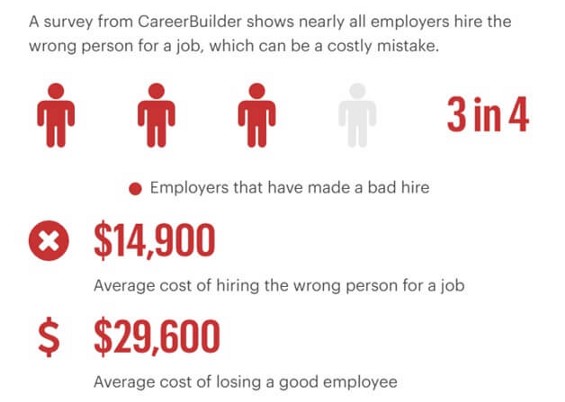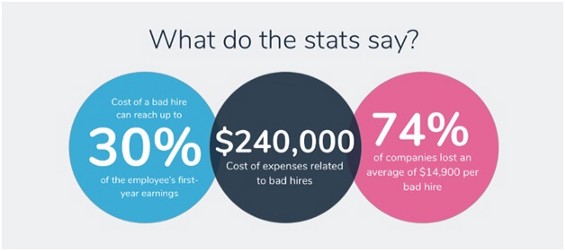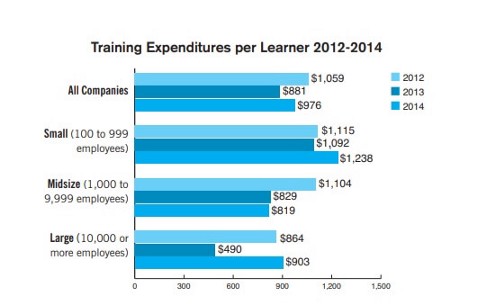Many rapidly growing companies make a huge mistake as they’re trying to scale. Desperate to fill in the gaps as quickly as possible, they often hire the wrong people for those positions. And bad hiring decisions can cost a company thousands of dollars and a thousand more on employee disengagement and bad company reputation.
According to a survey by Career Builder, out of 6,000 hiring professionals worldwide, more than 50% said they had experienced the negative effects of hiring a bad employee. As they’re caught in a competitive marketplace, companies are pressured into maintaining high-quality standards, keeping clients happy, and costs under control.
But just how costly making a bad hire is? What price do companies have to pay?
Here’s a detailed insight into the cost of a bad hire and what you can do to avoid it.
What is a bad hire?
Even the most experienced recruiters will admit it: they’ve hired a bad employee. Although a candidate’s resume was spectacular, and they did great at the interview, they turned out not to be a fit for the company. There are many reasons why a company can hire a bad employee and the most common include:
- Feeling pressured to fill the gap quickly.
- Having a hard time locating great talent.
- Focusing on skills and not attitude.
- Failing to do a complete background check.
There are many aspects of a bad employee. The most common characteristics are:
- A candidate that doesn’t have all the required skills.
- An employee that lies about their qualifications.
- Someone the company has outgrown.
- A worker who isn’t nice to be around.
- Someone who is lazy and too slow to get things done.
- An individual who is often late or skips coming to work.
- A worker who doesn’t produce the proper quality of work.
Someone who is not a team player.


How much does a bad employee cost?
According to the U.S. Department of Labor, the cost of a bad worker is at least 30% of the employee’s first-year earnings. For smaller companies with a limited budget, bad hiring decisions can be a threat to the business.
When you add up lost worker productivity, recruiting new employees, and training, the cost becomes considerable even for large-scale organizations.
Reduced Worker Productivity
One of the main traits of a bad employee is a drop in productivity. However, having poor performers at the company can lower the bar for other employees. Before you know it, you have a group of people who are missing work, disengaged from their projects, and who deliver poor quality of work. Even if you fire the initial bad employee, you’ll need to invest time and resources into improving the behaviors of your remaining employees.
Lost Time Due to Recruiting New Employees
According to LinkedIn’s 2017 global survey, hiring can take anywhere from a few days to four months. Meaning, finding a replacement for that bad employee can take an ample amount of time and money.
Apart from time and money, hiring a new employee can delay your operations. Depending on your industry, this can be devastating. In some cases, filling that vacancy can take you several months, putting pressure on recruiters and frustrating hiring teams.
If the hiring team struggles to reach a consensus, the hiring process can be prolonged, and the best candidates might find jobs elsewhere. And the process starts anew.


Expenses in Training a New Employee
Recruitment and administrative costs are just the beginning. Even if your new hires have a few years of experience up their sleeve, they will need some time to get used to the company’s culture and tasks.
The costs of training depend on how knowledgeable and skilled candidates are when starting a new job. For example, a software engineer who has experience in the field may only need one week of training. On the other hand, if the candidate for an assistant manager position has little management experience, they may need several weeks of training to get prepared for their new role.
According to the 2014 Training Industry Report from Training magazine, on average, companies spend roughly $1,200 per employee on training. What’s more, the Society for Human Resource Management points to some hidden costs that come with training a new hire. They include:
- the costs of the supervisor
- the costs of an employee’s time during training
- equipment
- instruction materials
- the cost of a mentor’s time
Negative Impact on Employee Morale
Many recruiters would rank negative employee morale higher than monetary losses. Why? Because one bad apple can spoil the bunch. Low morale is contagious, which may be why employers can’t seem to defeat it.
It can be so destructive that it can lead to dissatisfaction, low productivity, absenteeism, and turnover.
A survey from staffing agency Robert Half has discovered some devastating facts. Even though the majority of managers notice a bad employee within a month of hiring, it takes an average of up to nine weeks to let that person go.
When a disengaged employee doesn’t perform their tasks, the weight might fall on your good employees. In the end, they might get burned out from doing too much work and leave your company. You’ll lose your key employees and would need to invest money and time to find their replacement.
Negative Impact on Client Solutions
Hiring a new employee costs money but it can also delay operations. Your company’s inefficiencies can be felt by clients, whether they’re sales, administrative, service, or product-related. All of these inefficiencies have the power to stain your company’s reputation and damage your company brand in the long-term.


Key Takeaways
To sum up, a bad hire can lead to:
- A drop in productivity. Before you know it, you’ll have a group of people who are missing work, disengaged from their projects, and who deliver poor quality of work.
- The company spending money by recruiting a replacement.
- More expenses in training a new employee.
- Negative employee morale that involves dissatisfaction, low productivity, absenteeism, and employee turnover.
- Delayed operations and dissatisfied clients.
The next time you need high-quality candidates, work with a human resources staffing agency to make a hire you won’t regret! It’ll save you a lot of money and stress in the long run, and your company will become a more productive and engaging place to work.









